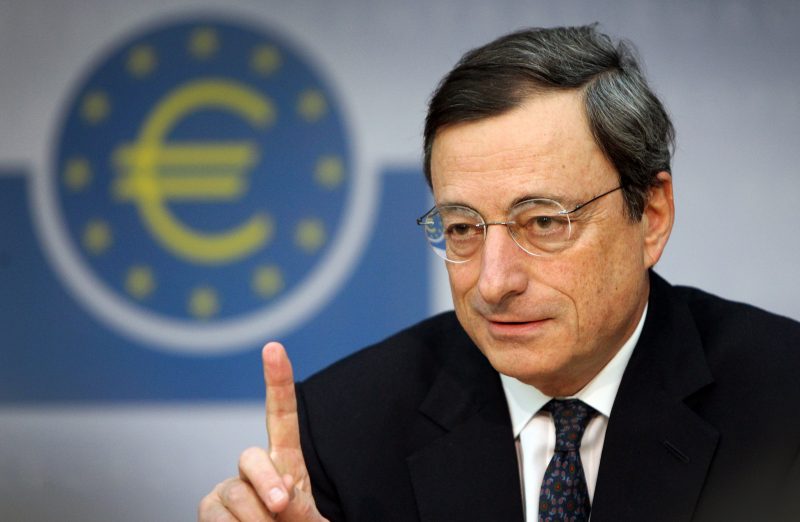ECB under pressure to ease growth, inflation fears
ECB chief Mario Draghi is expected to try and concerns about eurozone growth at a Thursday press conference (DANIEL ROLAND)
Vilnius (AFP) – European Central Bank chief Mario Draghi is expected to outline plans on Thursday to offer fresh assistance to banks and hint at further options to counteract rising worries about growth and inflation in the eurozone.
“Market participants will turn to Mario Draghi for any new hint at how exactly all (the) ECB’s instruments could be implemented, if needed,” said Frederik Ducrozet, a strategist at Pictet Wealth Management.
At his 1230 GMT press conference, Draghi is expected to repeat his April stance that the bank stands ready to open its “toolbox” that contains “plenty of instruments” to respond to any downturn.
After a weak patch for the eurozone in late 2018, economic expansion bounced back between January and March, gaining 0.4 percent from the last quarter.
That should normally be good news, with faster growth accelerating inflation towards the central bank’s price stability target.
However, trade tensions between the United States and its main partners China, the European Union and Mexico have stoked fears that a hoped-for stronger second half to 2019 will not materialise.
On top of overseas threats, worries closer to home include a budget confrontation between Brussels and Rome, elections in Greece and a possible no-deal Brexit, following the looming departure of British Prime Minister Theresa May.
Economists say business confidence surveys undermined by uncertainty and subdued market expectations for price growth add up to a need for the ECB to do more.
Eurozone inflation fell back to just 1.2 percent in May, from 1.7 percent in April.
– ‘Bold measures’ –
Meanwhile so-called “five-year/five-year” swaps — which reflect how financial players judge the pace of price growth between five and 10 years from now — currently almost match their mid-2016 level of 1.25 percent, their lowest ebb under Draghi’s eight-year tenure.
That is far from the central bank’s inflation goal of just below 2.0 percent.
“The risk has grown of inflation expectations becoming ‘de-anchored'” from the ECB’s target, said Eric Dor of France’s IESEG business school.
When ECB policymakers last met in April, Draghi said it was “too early to decide” on the exact conditions for the third round of the so-called Targeted Long-Term Refinancing Operations (TLTROs).
Past iterations of the scheme saw the central bank offer banks low- or negative-interest loans in exchange for them lending on the cash to the wider economy.
Equally generous terms could be in the offing this time around “to avoid giving the impression of monetary tightening,” Dor said.
– Fine balance –
Policymakers must strike a balance, avoiding making banks — especially those in Italy — dependent on the cheap cash, while making the injection significant enough to increase lending, in turn boosting growth and inflation.
The central bank could also push the first date for a possible interest rate hike in its “forward guidance” policy statements further into the future than current language which points to early 2020.
Another option the ECB is “looking at” is a so-called “tiering” scheme that would exempt some banks’ deposits in Frankfurt from a costly negative interest rate of -0.4 percent.
The charge, mostly paid by German and French banks, costs lenders around 7.5 billion euros ($8.4 billion) per year.
“Under pressure or not, the ECB will do everything it can to keep the ‘whatever it takes’ spirit alive,” ING Diba bank economist Carsten Brzeski said — harking back to Draghi’s watershed 2012 speech widely credited with keeping the euro intact.
Less likely for now — because it’s fraught with political risk — would be a relaunch of “quantitative easing” (QE) net purchases of government and corporate bonds, which between March 2015 and December 2018 amounted to 2.6 trillion euros.
Observers will also pore over the latest quarterly economic forecasts from the ECB staff, who are expected to present a cautious take on how growth, inflation and other indicators will develop in the coming years.
With June’s meeting the first for former Central Bank of Ireland head Philip Lane in his new role as chief economist, any changes to the ECB’s forecasts over the coming quarters are sure to be closely scrutinised.
Disclaimer: Validity of the above story is for 7 Days from original date of publishing. Source: AFP.


